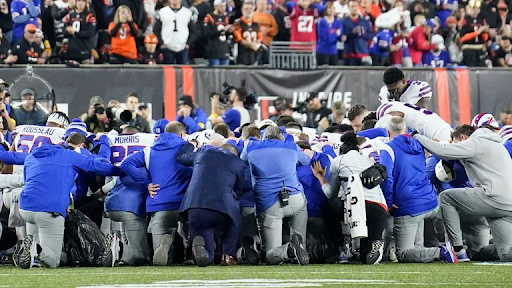Damar Hamlin collapse highlights issues in NFL safety

Bills players and staff rallied together in prayer after Hamlin’s collapse on January 2nd.
January 10, 2023
After suffering from cardiac arrest during a game, Buffalo Bills safety Damar Hamlin’s scary injury has highlighted many of the long term concerns associated with playing football.
On January 2nd, millions across the nation watched as the National Football League’s (NFL) highly anticipated Monday night “Prime time” matchup between the Cincinnati Bengals and Buffalo Bills kicked off. However, tragedy struck when Hamlin collapsed on the field after tackling Bengals receiver Tee Higgins.
The scene was devastating with players, staff, and thousands of fans on both sides crying, hugging, and praying on the field. However, the NFL would seem to care more about TV ratings than the players safety. According to a report by ESPN, the NFL had initially intended to continue the game even after Hamlin’s traumatizing injury. Although they eventually canceled the game, the NFLs initial willingness to continue shows their clear lack of priority for player safety.
Hamlin would later make a full recovery after being discharged from a Buffalo Hospital on January 10th. However, his injury reminded many fans how dangerous football can be.
One of the main concerns with Hamlin’s injury is the regularity of the hit that induced his collapse. In fact, some may say the hit was routine for many pro football players. The ordinariness of grown men running into each other at full speed shows many of the concerns within the sport’s safety, in fact 9/10 football players when surveyed stated they had either experienced or attempted to play through injury in their career.
The frequency and normalization of undergoing injury in the NFL could steer away upcoming generations. Despite being America’s most watched sport, broken bones, pulled muscles, torn knees, ankles, and shoulders have merely become a part of the game causing a 20 percent decline over the last ten years.
Players like Andrew Luck, former Indianapolis Colts quarterback, have had to end their career early due to excessive injury. Luck, a four time pro bowler and comeback player of the year retired at only 29 after suffering five major injuries in just six years in the league. Luck’s injuries kept him in a constant cycle of rehabilitation forcing him to retirement. However, some injuries in football can linger for years even after they occur.
In addition, injuries that can be sustained in football go even beyond physical trauma. Chronic traumatic encephalopathy (CTE) can be induced from repeated blows to the head, a common practice in football. Symptoms such as headaches, memory loss, and anger control difficulties are for life as there is no cure for CTE.
In fact, out of 202 former football players tested for CTE, over 87 percent had symptoms to some extent. When looking at only NFL players in that sample, the number was 99 percent. Due to the lavish lifestyles and large salaries related to the sport many players engage in head-to-head contact on a regular basis for the entirety of their careers without realizing the potential long-term hazards.
Even with dozens of injuries every season, the NFL has made little to no effort into ensuring player safety as a priority. Despite many star players advocating for safer fields and stricter regulations to reduce injury, the NFL has instead expanded the regular season to 17 games as well as considering expanding the playoffs. Even with calls to make the sport safer, the NFL has shown to be more worried about its revenue.






